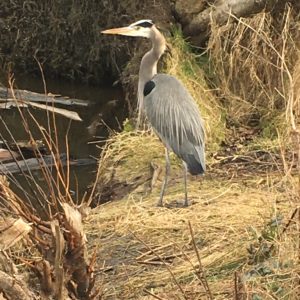Weather Report, April 4
Today is a mix of clouds and blue sky. The temperatures remain lower than normal for us, in the 40’s during the daytime.
Though it was on the chilly side, I paddled my kayak up Salmon Bay to the Great Blue Heron rookery (nesting area) that is southwest of the Locks in Ballard. It’s nesting season for the herons and there was a lot of activity in the rookery. Most of the nests appeared to be occupied.
 Nests are reused year after year in a rookery. The male birds arrive first, selecting a nest and doing some spring clean-up, fix-up. Then they wait, hoping to entice a mate to their nest. After the female makes her choice, she does some additional cleaning and rearranging before settling down to business. In the photo to the right there are 10 or so herons visible. On the right side they are mostly on nests. Then, on the left, a half dozen, probably males, hang about in the alders.
Nests are reused year after year in a rookery. The male birds arrive first, selecting a nest and doing some spring clean-up, fix-up. Then they wait, hoping to entice a mate to their nest. After the female makes her choice, she does some additional cleaning and rearranging before settling down to business. In the photo to the right there are 10 or so herons visible. On the right side they are mostly on nests. Then, on the left, a half dozen, probably males, hang about in the alders.
Why do herons, normally solitary, nest together? Protection. One mama heron versus an eagle is over matched. But five to 15 herons is a different matter. This rookery used to have its own security, an osprey (water hawk) that roosted nearby and would go after eagles that got too close. But someone hassled the osprey with a drone, so she took off leaving the herons to their own devices.
 The Great Blue Heron, who is really more grey than blue, has sixteen vertebra in its long, incredibly flexible, neck. That allows a heron, who mostly waits for fish and other aquatic life in watery shallows, to strike with great speed and force should a frog or fish venture nearby. Herons, when threatened by humans, have been known to strike. They go for the eye, which is some instances has proven fatal as their arrow sharp beak pieces through the eye to the brain. Herons, with their stilt-like legs and expansive wing-spread evoke the evolutionary link between some bird species and dinosaurs.
The Great Blue Heron, who is really more grey than blue, has sixteen vertebra in its long, incredibly flexible, neck. That allows a heron, who mostly waits for fish and other aquatic life in watery shallows, to strike with great speed and force should a frog or fish venture nearby. Herons, when threatened by humans, have been known to strike. They go for the eye, which is some instances has proven fatal as their arrow sharp beak pieces through the eye to the brain. Herons, with their stilt-like legs and expansive wing-spread evoke the evolutionary link between some bird species and dinosaurs.
A kingfisher worked the shore as I paddled back. I’m not sure quite what it is that is so engaging about a kingfisher, but they are, at least to me. They are very fast, diving into the water after fish. Lots of ducks on the water, mallards which are also mating, buffleheads and a couple mergansers. Mergansers have a wonderful, sweeping rust-red colored “duck tail” on the back of their heads. As I crossed the water toward Secret Beach, where I put in and get out, a bald-eagle swept by. No seals or sea lions today which is unusual.
This week the weather is supposed to turn warmer, up into the 60’s which will bring people out. But most everyone seems to be being careful about keeping the proper distance. A reader, Susan Dittig, tells me she calls what we’re asked to do “physical,” rather than “social,” distancing. That’s a good distinction. You can still be social from six feet away.
![Anthony B. Robinson [logo]](https://www.anthonybrobinson.com/wp-content/themes/anthonybrobinson/images/logo.png)
![Anthony B. Robinson [logo]](https://www.anthonybrobinson.com/wp-content/themes/anthonybrobinson/images/logo-print.png)